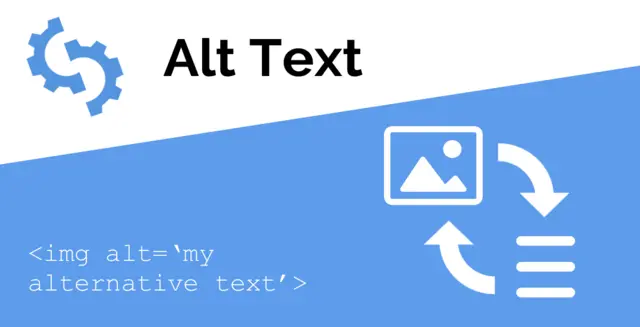
Small things can have a big impact on the world of digital marketing. One such feature is the use of alt attributes for photos. Alt characteristics are crucial for SEO and accessibility, even if they might seem like a minor component of page optimization. In this article, we'll go over what alt tags are, why they're significant, and how to use them to enhance the functioning of your website.
Importance of Alt Attributes
More than just a text description added to an image, alt attributes are essential for improving search engine visibility and making sure your website is accessible to all users. Regardless of your degree of web development skill, understanding the importance of alt attributes is essential to getting better outcomes from your site optimization efforts.
What Are Alt Attributes for Images?
Definition of Alt Attributes
Alt attributes, often known as alt text, are descriptive text snippets that are added to an image's HTML code on a webpage. They serve as a substitute for images if they cannot load and help search engines understand the content of images. If your website has a picture of a red apple, for instance, the alt attribute might read "A fresh red apple on a white background."
Role in Accessibility
Alt tags are crucial for ensuring that people with visual impairments can use your website. Screen readers utilize alt text to describe images on a page so that individuals who are blind or visually impaired can better understand what they are seeing. Without alt attributes, a visitor with vision impairment might not notice crucial information, which could make their visit to your website unpleasant.
SEO Benefits
From an SEO perspective, alt attributes are a helpful instrument. Search engines like Google rely on alt text to decipher what an image is trying to depict because they are unable to "see" photos. You may improve your image SEO using well-designed alt tags, which could lead to better rankings in image search results and more visitors to your website.
Why Alt Tags Matter in Images
Alt Tags and Search Engines
Search engines utilize alt text as a tool to decipher the content of photos. If you don't employ alt tags, search engines won't be able to properly index or rank your photographs. This could mean that there are fewer opportunities for your website to appear in relevant search results, especially for picture searches, which are increasingly important given today's visually-focused online society.
Impact on User Experience
In addition to SEO, alt attributes have a significant positive impact on user experience. Let's say that one of the users of your website is experiencing slow internet, causing your photographs to not load. The user can still decipher the significance of the photographs even with alt text. Additionally, for screen reader users, alt features mean the difference between an inclusive and exclusive experience.
Alt Tag Example
Let's revisit our example of the red apple to see how an alt tag should be written. Whereas an alt tag with a lot of keywords would say "fruit," one without any keywords might say "buy red apple fresh red apple apple fruit online." Neither is ideal. A short, expressive alt tag like "A fresh red apple on a white background" accomplishes the perfect balance by providing context without going into unnecessary detail.
How to Write Effective Alt Tags
Best Practices
Being brief and descriptive is the aim of writing alt text. Make an effort to give a succinct, accurate explanation of the picture that is nonetheless relevant to the main points of the article. A picture of a woman using a laptop may include the alt tag "Woman typing on a laptop in a cozy office space."
Avoiding Common Mistakes
There are a few things to be cautious of when designing alt text. One of the most common mistakes is "keyword stuffing," or putting too many terms into the alt attribute. This can make the text illegible and result in penalties from search engines. Including alt attributes but leaving them undefined or unduly vague is another mistake that defeats their purpose.
Alt Tag Example
Imagine a busy city street at all hours of the night. A decent alt tag might read "city street," but an awful one would read "busy city street at night with bright neon lights and people walking." The latter provides a clearer image of the scene, making it better for accessibility and SEO.
Tools to Help Optimize Alt Tags
SEO Tools for Alt Text
Many of the tools available can help you make your alt characteristics more SEO-friendly. They can assist you in refining your strategy by highlighting issues such as excessive or superfluous alt text or absent alt tags.
Accessibility Checkers
Axe and WAVE are two very helpful tools for ensuring that the alt text in your content conforms with accessibility standards. With the use of these tools, you can ensure that your material is properly experienced by all users, irrespective of their abilities. The tools have the ability to examine your website and identify areas where your alt attributes may be lacking.
Common Challenges and Solutions
Common Challenges
Writing alt text for intricate photographs or balancing search engine performance with user accessibility can be challenging. For example, how would you describe an infographic with a lot of accurate information or an abstract piece of art whose meaning isn't immediately clear?
Solutions
One option to fix the issue is to focus on the image's most important components that are related to the context of the page. A fuller description could be required anywhere on the page or in the alt text for complex photos, such as infographics. Consider the message or emotions that an abstract image is attempting to convey when composing the alt text for that image.
Conclusion
Images' alt properties are crucial for accessibility and search engine optimization. You can boost user experience, make sure your content is accessible to everybody, and increase search engine exposure for your website by creating compelling, descriptive alt text. Spend some time going over and improving your website's alt tags. It's a simple action that can have a big impact on how well your website functions and how visitors interact with it. Stay connected with our blog to learn more.
What to read next

